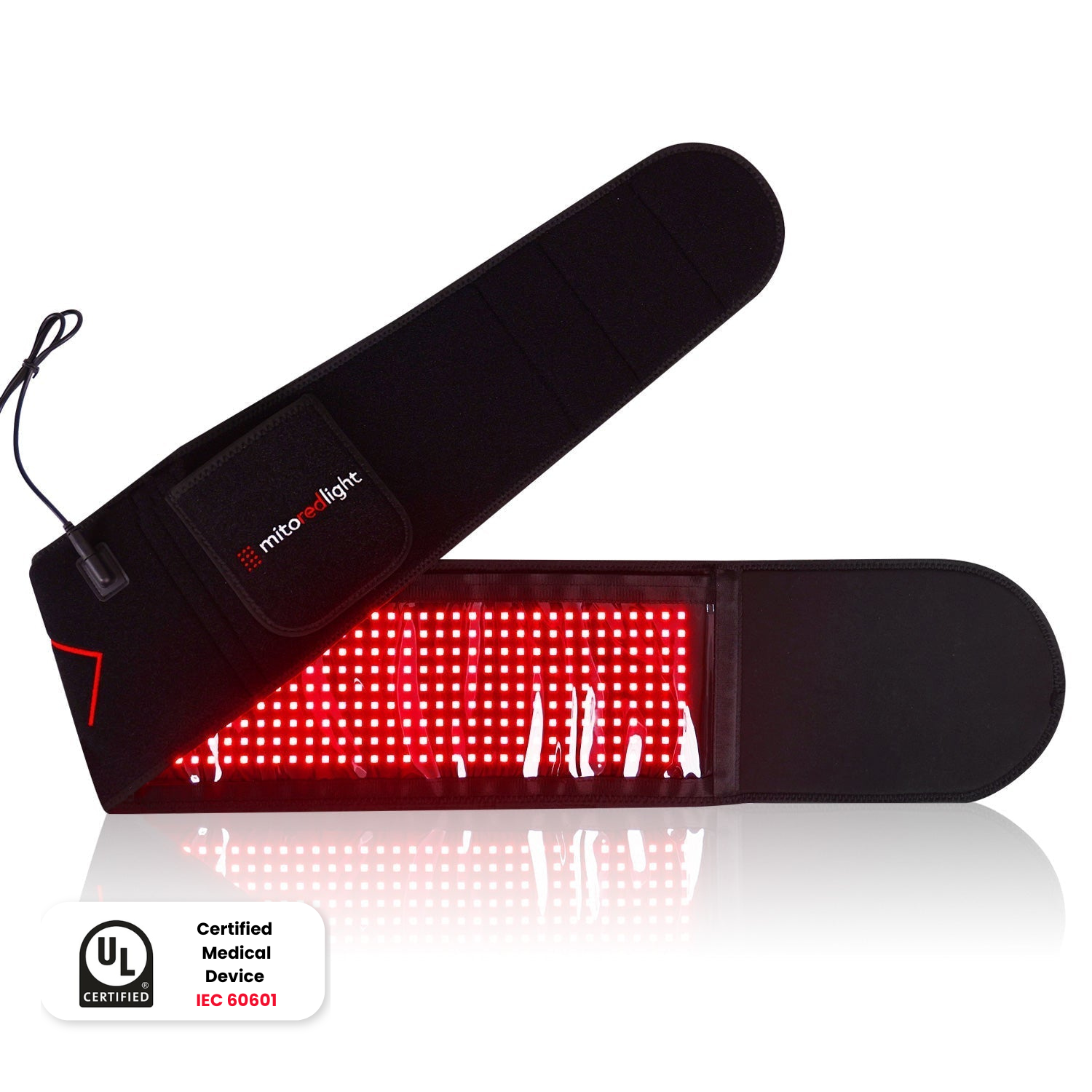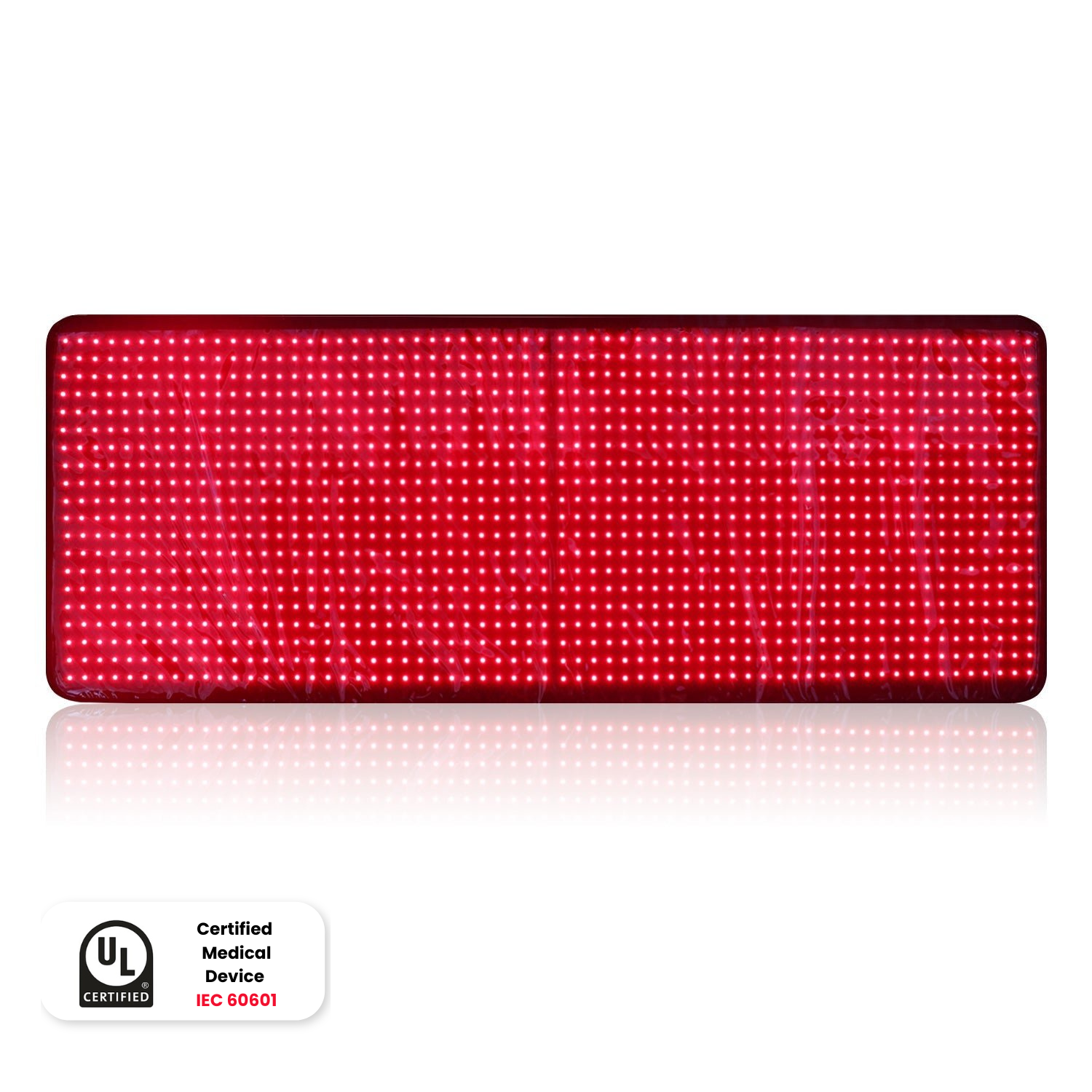DISCLAIMER: Mito Red Light devices are Class II wellness devices aimed at affecting the body through topical heating and supporting cellular function. The information provided in this article and on this site is for educational purposes only and is not intended to imply effectiveness of Mito Red Light devices for any specific application. The information provided in this article and on this site is not intended to diagnose, treat, cure, or prevent any disease, is not a substitute for consultation with a licensed medical provider and should not be construed as medical advice. Click here to read our article on potential contraindications of red light therapy..
Red light therapy is a type of therapy using red and infrared wavelengths of light to stimulate your cells. People are using it to speed up wound healing, reduce skin blemishes, improve muscle recovery, and achieve many other benefits.
Red light therapy is also sometimes called photobiomodulation or low-level light therapy. The pioneering work of Danish physician Niels Finsen established the foundation for the medical use of light-based therapies. Finsen won a Nobel Prize in 1903 for his use of phototherapy in treating lupus and smallpox, laying the initial groundwork for photobiomodulation research.
The growing popularity and versatility of red light therapy, particularly within health and wellness communities, emphasizes the importance of understanding this technology and its implications. People are using it in a variety of settings, from high-tech skincare clinics to home-based wellness centers, demonstrating its potential to promote wellness for anyone.
Understanding the Science Behind Red Light Therapy
While the idea that simply exposing your body to certain wavelengths of light can have a biological effect might sound bizarre or even scammy to some, there are many proven examples of this occurring. The most obvious examples primarily center around a different wavelength of light: ultraviolet (UV) light.
Ultraviolet light has a few important biological effects that have been well-proven for decades:
- Melanin production - If you’ve ever been sun tanning, you’ve seen the biological effects of light in action. UV light stimulates your skin cells to produce melanin, a pigment in the skin. This effect is what makes fair-skinned people tanner after being out in the sun for several minutes.
- Vitamin D production - Our bodies’ primary source of vitamin D isn’t from food; it's from UV light. Exposure to UV light stimulates vitamin D production by skin cells.
- Bilirubin breakdown - Infants can sometimes have high levels of a chemical called bilirubin after birth, potentially causing toxic effects. UV therapy breaks down bilirubin and is used to treat infants in hospitals around the world.
Like UV light, red light and infrared light can also affect your body. The effects of these wavelengths, however, are a bit less obvious than having tanner skin after being exposed to it. Red light therapy works by stimulating tiny organs within your cells called mitochondria. These important parts of the cells produce the energy that cells use throughout the body.
Specifically, red and infrared light is absorbed by a chemical in the mitochondria called cytochrome C oxidase. This molecule is part of the chemical reaction that produces another important molecule called adenosine triphosphate (ATP). ATP is how cells store, transfer, and use energy.
Increased energy production allows cells to replicate faster, allowing for more rapid healing or recovery. It also helps to improve their function, allowing them to potentially live longer and do more. Red light therapy is also thought to help suppress inflammation, helping to further enhance healing and reduce the pain inflammation can bring.
Applications and Uses of Red Light Therapy
There are many different potential applications for red light therapy. Some potential applications have been known and studied for decades, while others have only been uncovered more recently. Let's explore some of the more important ones.
Skin Health and Anti-Aging
One significant cause of aging in the skin is the diminished production of collagen, a protein responsible for skin elasticity and firmness. Red light therapy can help stimulate increased collagen production, helping to improve skin elasticity and fullness.
Additionally, red light therapy can promote the rapid healing of skin blemishes and scarring, helping the skin to achieve a more even and youthful skin tone. When combined with the improved quality and elasticity of the skin that improved collagen production provides red light therapy can provide a powerful tool for reducing the effects of aging on the skin. Red light therapy is ultimately an important part of any skincare routine.
Wound Healing and Tissue Repair
One of the most impressive attributes of red light therapy is its potential for wound healing and tissue repair. This benefit of red light therapy was the first major benefit recognized during NASA experimentation in the 1990s. Red light therapy aids wound recovery by promoting cellular repair and regeneration. The red light stimulates the energy production in cells, helping them to function more efficiently and accelerating the healing process. This can be particularly beneficial in treating wounds, burns, and other injuries where rapid healing is crucial. Interestingly, red light therapy has also been found to reduce scar tissue in some cases, promoting smoother, healthier-looking skin after an injury.
Inflammation Reduction
Inflammation causes swelling, creating pressure on nerves that can lead to pain and sensitivity. Inflammation and the pain it causes are common with many different health conditions, and managing inflammation can significantly enhance the quality of life for a wide variety of conditions.
Red light therapy can help suppress inflammation by improving how well cells are able to respond to injuries, whether they are chronic or acute injuries. Consequently, it's been beneficial in conditions ranging from arthritis, where inflammation of joints causes discomfort, to back pain, and even carpal tunnel syndrome. Its use in these conditions to alleviate pain works by reducing inflammation. This can also lead to an overall improvement in function and mobility in addition to improving pain levels.
Fitness and Muscle Recovery
The healing properties of red light therapy are not just limited to the skin. Red light and infrared light can penetrate deep into muscle layers, offering potential benefits for anyone who works out.
By stimulating mitochondrial activity and increasing ATP production, red light therapy can help heal the microscopic injuries caused by intense workouts. This allows the muscle cells to repair and rebuild more quickly, reducing inflammation and muscle fatigue. The enhanced ATP production can also lead to performance improvements, giving athletes and fitness enthusiasts an edge in their training regimens.
Hair Loss
Hair loss is a common concern that can affect both men and women, often leading to significant distress when it does occur. While there are various treatments available, many are invasive or have potential side effects. Red light therapy offers a promising alternative that is less invasive and more natural.
Red light therapy improves cellular reproduction but also improves blood flow by stimulating the release of nitric oxide, a chemical that dilates your blood vessels at the site being treated. Increasing circulation and stimulating cellular activity in the scalp can ultimately promote hair follicle health. This can help slow hair loss and even promote new hair growth, presenting a non-invasive and side-effect-free option for conditions that cause hair loss.
Sleep Quality Promotion
Good sleep is crucial for overall health, affecting everything from mood and memory to physical well-being and disease risk. Red light therapy can help promote quality sleep by regulating the body's circadian rhythm, our internal biological clock that governs sleep-wake cycles.
Red light therapy influences sleep quality by modulating the production of melatonin, the sleep hormone, helping individuals fall asleep quicker and experience deeper, more restorative sleep. As a result, those who use red light therapy often report better sleep and feel more rested upon waking.
Cognitive Function Enhancement
Red light therapy has shown potential for improving various aspects of cognitive function, from memory to attention. Red light therapy can increase blood flow in the brain while also enhancing the performance of brain cells. It can also reduce inflammation and oxidative stress in the brain, two factors linked to cognitive decline.
Research into the use of red light therapy to improve cognitive function is newer; however, it is being explored as a potential means of slowing the progression of neurodegenerative diseases like Alzheimer's. Red light therapy may offer a promising approach to maintaining brain health and optimizing cognitive function, further illustrating the wide-ranging potential of this innovative therapy.
While there are many potential uses of red light therapy, it is not a one-size-fits-all solution. Its effectiveness can vary depending on the condition being treated, individual health status, and how it is used. Red light therapy often is used to supplement and augment treatments or therapies that are already being used but can also be used all by itself. Red light therapy can be a powerful wellness therapy but should never be used in place of treatments recommended by a medical professional.
How to Use Red Light Therapy
Red light therapy can be done either in a professional setting to augment medical treatment or at home to promote general wellness and provide long-term benefits. Ultimately, the effectiveness of both professional and home treatment options will depend on the quality of the red light therapy panel being used and how it is used.
Using red light therapy is quite straightforward, and pretty much anyone should be able to do it on their own Prior to using red light therapy, you should consider possible contraindications. Red light therapy is considered to be quite safe; however, there may be some rare situations that limit how you can or should use it.
The steps to using red light therapy are generally the same for most uses and individuals:
- Make sure you have a treatment-grade therapy source.
- Ensure you have protective eyewear on.
- Expose the area being treated.
- Position the source about 12-16 inches from the area you are treating.
- Use the treatment for 10-20 minutes.
- Repeat treatments regularly, about three to seven times a week.
Recommendations for the specific distances from the red light source and the timing for treatments may vary based on the source you are using. You should always follow the advice of the manufacturer or your physician when using red light therapy.
Mito Red Light
Red light therapy can be quite beneficial, but only if you are using a high-quality source. The wavelengths that provide the optimal effect are quite specific and it is important to ensure that you are using a device that provides the correct wavelengths.
At Mito Red Light, we are committed to providing the best quality red light products available. Our red light therapy panels provide reliable doses of professional-grade red light therapy, optimizing the effect that red light and near-infrared light will have on your health. We welcome you to review our selection of high-quality products or to contact one of our expert representatives at 1-866-861-6486(MITO).
Related Articles:
- What Is Red and Near Infrared (NIR) Light Therapy?
- Red Light Therapy Buyer’s Guide
- Everything You Need to Know About Red Light Therapy and SKIN






























